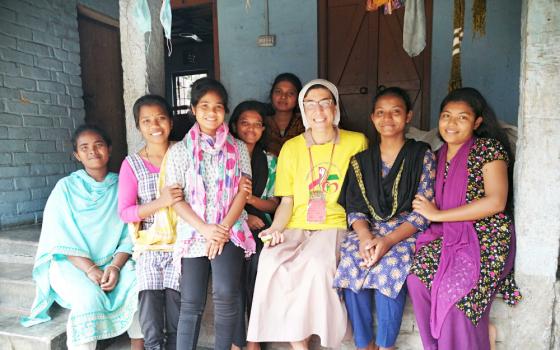
CHICAGO -- "We have to do something." A simple message spoken by a young woman, recalled by her father, was honored with the dedication of the Lizzy Seeberg Volunteer House at Christ the King Jesuit College Preparatory High School in Chicago.
It's been nearly two years since Lizzy died by suicide, nine days after she reported a sexual assault at the University of Notre Dame campus in Indiana. In the midst of grief and mourning, her family's efforts to remember how she lived was achieved on May 6 this year as the house dedicated in her name will shelter a volunteer team for the high school she passionately raised money for during her short life.
"She had a special ability to see need in others. She asked the tough questions at such a young age," said Tom Seeberg, Lizzy's father.
The three-flat in Chicago's Austin neighborhood will house a team of seven Jesuit Alumni Volunteers, a group of graduates from Catholic universities who work as teachers, coaches, chaperons and mentors. They currently reside miles away in the Pilsen neighborhood.
"Our dedicated team of young adult volunteers will call the rehabbed apartment building home as they teach, minister and mentor our students," according to a press release.
Nineteen-year-old Lizzy was one of Christ the King's most passionate volunteers. Following her death, a memorial fund was established in her name and has helped raise more than $250,000 to purchase and renovate the home across the street from the school, a fairly new campus that serves residents in the troubled neighborhood. All of the labor for the house was done pro bono, Seeberg said.
 Lizzy became involved in volunteer work with Christ the King in 2008 after reading fundraising materials that she had found in her house. Her father recalls Lizzy, then a junior at suburban Glenbrook North High School, recognizing the opportunities she was given growing up on the North Shore.
Lizzy became involved in volunteer work with Christ the King in 2008 after reading fundraising materials that she had found in her house. Her father recalls Lizzy, then a junior at suburban Glenbrook North High School, recognizing the opportunities she was given growing up on the North Shore.
"She said to me, 'What does it mean that I wake up every day without even thinking about my safety, without even thinking about my home life, without thinking about getting an education, and 25 miles away, these kids don't have that? How does that add up?' " Seeberg recalled about his daughter. "Her next question for me was, 'Well, what are we going to do about this?' "
Lizzy pulled a team together from her church youth group to paint and sell wooden picture frames and personal message chalkboards to benefit the school.
"It was like a sweat camp in our back yard. The ozone will be massively depleted from all the spray-painting," Seeberg jokingly said.
Her efforts and affection for Christ the King prompted her father's involvement as a member of the president's advisory council for the school.
"Seeing Lizzy getting engaged at that young age with those questions helped me see that you can't be passive and you need to get engaged and involved," Seeberg said. "Why are we all here? And what's our commitment to this? Well, I'm here, I'm engaged, I'm involved ... opening up opportunities to kids who don't have a lot."
Christ the King serves the community in a much different way than the conventional high school setting, by using the Cristo Rey model that integrates a corporate work-study program -- a partnership between urban education and the business community that allows students to earn three-quarters of their tuition costs through jobs at Chicago-area companies and to gain life-changing skills and career experience.
"It's not a model that seeks to pick off the dream student or elite student or the smartest or the brightest like a lot of competition that have very strict standards of who they are going to let in and give this opportunity to," Seeberg said. "It's designed to reach right in the middle. These kids still have to have the willingness and the support to make it through."
Since the Cristo Rey model's inception in 1996, the new urban way of learning has expanded to 24 schools nationwide and nearly 98 percent of all graduates attend a college or university. Christ the King was the 20th school to acquire this model.
"There's pressure, if you will, from the community they grew up in to just not [try in school]. The standard is that this is your life. All the messaging around you would suggest that this is not the route. 'Come join the gang, be one of us, this is too hard,' and it is hard. It's a pretty rigorous schedule," Seeberg said.
Christ the King stands out on Jackson Boulevard as fresh development in the neighborhood, designed with stainless steel modern architecture and large windows that welcome the curiosity of onlookers.
"The architecture is supposed to resemble a corporate setting but with academia, designed for the corporate world for the work-study program," said Mary Beth Sammons, director of communications at Christ the King. "The cafeteria was intentionally put up to the curb so people could look in and see what's going on."
"This school is a bold statement of 'We're here,' " Seeberg said.
Michael Laughlin, a graduate of Loyola University in Chicago, is a first-year Jesuit Alumni Volunteer who will soon move into the house. He said he plans to lead a life of service in memory of Lizzy.
"I grew up in middle-class white suburbia," Laughlin said. "I fell in love with the school, with the mission and the community. I've learned patience and perseverance. [The students] come into school with problems that I would never have imagined. It's nice to have the support and to serve in the community where you also live. You can try to feel what their everyday lives are like."
On the third floor next to the kitchen and dining room a large message chalkboard was painted on a wall to remember the assertive, yet simple, beginning of Lizzy's vision -- to help others in need and not to stay passive.
[Kaitlin Kimont is a freelance writer based in Chicago.]



